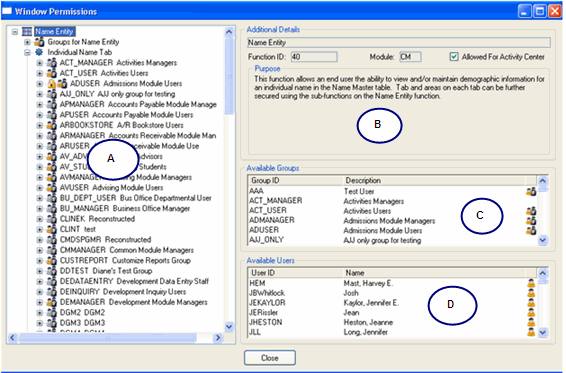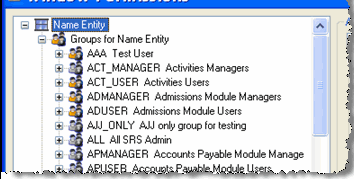Window Permissions Window (F11)
Press F11 on any J1 Desktop window

|
|
A Tasklist security row exists for the F11/Window
Permissions window. Only application groups with access to this
window can open this window. If you do not have permission to
the Window Permissions
window, you can press F11
but nothing will appear, not even a message indicating lack of
access to the window. |
This window allows you to manage security for each window while you
are using that window, eliminating your having to go back and forth from
the current module you are using to the Tasklist module to manage security
for each window. However, any changes you make in this window will be
saved to the Tasklist module.
The Window Permissions window
for the Name Entity window is used
as an example in this Help topic.

The sample window above is an example of the window that initially opens
when you press F11 from a J1 Desktop
window. It includes:
A |
Permissions Tree |
B |
Additional Details |
C |
Available Groups |
D |
Available Users |
Permissions Tree

The Permissions Tree always displays the name of the J1 Desktop window
at the top of the tree (the window on which you clicked F11), identified
by the  icon. When expanded, the Groups
for <window name> node (identified with the
icon. When expanded, the Groups
for <window name> node (identified with the  icon) lists groups that have access to that window as well as application
users assigned to those groups. Also included in the tree is a listing
of all sub-functions (like tabs, buttons or other secured controls on
the main J1 Desktop window), identified by the
icon) lists groups that have access to that window as well as application
users assigned to those groups. Also included in the tree is a listing
of all sub-functions (like tabs, buttons or other secured controls on
the main J1 Desktop window), identified by the  icon,
with the application groups and users that have been granted access to
those sub-functions.
icon,
with the application groups and users that have been granted access to
those sub-functions.
· If groups have members,
the  icon is displayed beside the
group.
icon is displayed beside the
group.
· If groups do not have
members, the  icon is displayed
beside the group.
icon is displayed
beside the group.
· Users in the tree are
represented with the  icon.
icon.
· The  icon indicates that a group has “view only” permission to the window or
sub-function.
icon indicates that a group has “view only” permission to the window or
sub-function.
Additional Details
This section has three different views, depending on the node you click
in the Tree.
· Window/Sub-function
view:

When you click on the main window in the root of the tree or a sub-function,
you see a view displaying the name of the J1 Desktop window or sub-function
and its related Function ID, Module code, and whether it is allowed
to be used in an Activity Center. The Purpose
text box is for future use and will be populated with Jenzabar-provided
default data, which will describe the main window or sub-function.
· Application
Group view:

When you select an application group in the Tree, you see a view that displays
the application group Description
and Group ID, as well as the Functions Permissions for this Group,
which details all of the windows and functions that have been granted
to that group, not just for the J1 Desktop window you are currently viewing.
· Application
User view:

When you select an application user in the Tree, you see a view that displays
the application User ID and Name, Name Master ID
Number, Active Directory User
name (how the user is identified in Active Directory), and Function
Permissions for this User, which details all of the windows and
functions that have been granted to that user. You will also see a listing
of application groups to which the application user belongs and can filter
the Functions Permissions for this User
display by selecting one or more of those application groups so that you
can see from what application group a user received access.
Available Groups

All available application groups are displayed. The  icon beside a group indicates that this group has assigned members.
icon beside a group indicates that this group has assigned members.
· If you hover the mouse
over the icon, a message tells you that the group has members.
· If you click the icon,
a popup window displays the groups of which the user is a member.
Application groups can be dragged to the Permissions Tree and dropped
on the “Groups For…” node in the tree (which means you are granting access
to that group to the main window in the root of the Permissions Tree)
or sub-functions of the main window. You can also drag more than one group
to the Permissions Tree by utilizing the Shift + Click and Ctrl + Click
methods.
Available Users

All available application users are displayed. The  icon beside a user indicates that this user is a member of one or more
groups.
icon beside a user indicates that this user is a member of one or more
groups.
· If you hover the mouse
over the icon, a message tells you that the user is a member of one or
more groups.
· If you click the icon,
a popup window displays the groups of which the user is a member.
Application users can be dragged to the Permissions Tree and dropped
on any application group in the tree, making that user a member of that
application group. You can also drag more than one user to an application
group in the Permissions Tree by utilizing the Shift + Click and Ctrl
+ Click methods.
How To
 Remove
an Application Group?
Remove
an Application Group?
 Assign
View Only Access for Functions/Subfunctions for a particular group?
Assign
View Only Access for Functions/Subfunctions for a particular group?
 Remove
View Only Access for Functions/Subfunctions for a particular group?
Remove
View Only Access for Functions/Subfunctions for a particular group?
 Remove
an Application User?
Remove
an Application User?
![]()








